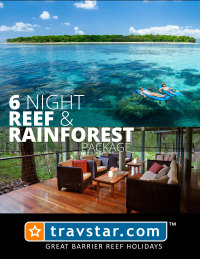The Daintree Rainforest
Rainforests don’t get much more special than the Daintree, one of the most unique ecosystems in the world...
The Daintree Rainforest is over one hundred and thirty-five million years old. This is the only World Heritage listed area in the world where two ecosystems exist side by side - the magnificent underwater world of the Great Barrier Reef and the lush tropical rainforests of the Daintree.
The Daintree rainforest is situated an easy 2-hour drive north of Cairns along one of the most beautiful coastal roads in the world. The Cook Highway north of Port Douglas offers beautiful scenery ranging from secluded palm fringed tropical beaches, hidden coves and rugged headlands to the rich green of lush sugar-cane fields and rainforest covered mountains.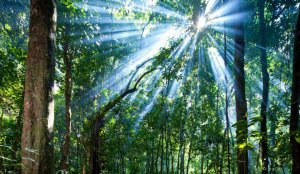
The Daintree region, encompassing the rainforest of Daintree National Park, extends over a large area. The northern section is often referred to as the “The Daintree” or the “Daintree Coast” and covers the coastal lowland area between the Daintree and Bloomfield Rivers and this is where “the rainforest meets the reef”.
The southern Daintree region stretches from the rainforest walks of Mossman Gorge on the Mossman River northwards to the Daintree River and includes rainforested coastal ranges, pristine beaches, tropical farmlands, a wildlife sanctuary, horse-rides, tropical gardens and tiny, historic Daintree Village which is still home to descendants of some of the original pioneering families.
Connecting the southern and northern Daintree regions is one of Australia’s last remaining car ferries, which operates across the Daintree River every day from dawn until late at night.
Daintree Village, which gave it’s name to the region, is perched on a bend of the Daintree River, just further on from the turn off to the Daintree Ferry. This little township and its surrounding scenic valleys have a permanent population of about 100 people.
Visitors are very well catered for with plenty of accommodation options, and restaurants and cafes offering fresh local cuisine. Daintree is also well known for it’s local arts and crafts. Visit the souvenir shops and also the timber gallery and pottery studio for many interesting and locally made gifts.
Wildlife of every kind flourishes on the Daintree River and its banks, it has become a bird watchers haven.
Riverboat tours are an excellent way to view the forest and its inhabitants. The area's most infamous inhabitant of all are the estuarine crocodiles. During the winter month’s daily visitors arrive to see crocodiles sunning themselves on the riverbanks, and view the rich and varied plant life in the rainforest and mangrove forests.
There are many locally owned and operated tour companies offering excellent guided rainforest walks, river cruises and wildlife viewing around the area.
Cape Tribulation
Find yourself in the only sport where world heritage rainforests share the coastline with the edge of the Great Barrier Reef.
Just south of Daintree's main road is one of Australia's last remaining car ferries, which you can take into an ancient world-heritage rainforest, the Cape Tribulation National Park. Cape Tribulation is just a small section of the Daintree National Park. The Daintree Cape Tribulation coast is where the Great Barrier Reef and the Daintree rainforest meet, the only place on earth where two World Heritage areas exist side by side.
The road is sealed as far as Cape Tribulation. After crossing the Daintree ferry you will travel through lowland and tropical rainforest passing road junctions for Cape Kimberley and Cow Bay. There are some excellent coastal views and several tourist attractions. The road runs over several high capes and alongside attractive beaches. Camping spots and accommodation are available.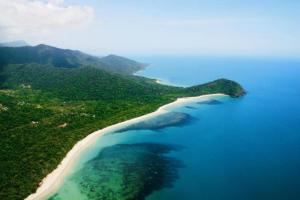
The drive over the Alexander range is a stunning scenic rainforest drive. The Alexandra Range Lookout offers excellent photo opportunities with views overlooking the Daintree River mouth, offshore islands and along the coast, from Wonga Beach to Port Douglas and Cairns.
The best part of the Cape Tribulation experience is the beaches. Most the beaches in the Daintree region are very similar - golden sand, calm blue water and mostly deserted. They are pristine.
Cape Tribulation Beach is the showcase beach of the area. Named by Captain Cook after the trials of becoming grounded here. The beach is protected by the Cape Tribulation headland, and the water is almost always calm and crystal clear. Tourist operators visit this beach every day of the week, so there are often many people here.
It's not surprising as this stretch of the coast is incredibly beautiful. It's one of the few places in Australia where the rainforest runs right down to the water. The Wet Tropical Rainforests are now protected by World Heritage Laws so tourists have the privilege of visiting unspoilt virgin rainforest and crystal clear jungle creeks.
Activities on offer include guided rainforest walks, four wheel drive safaris taking in local features, waterfalls, swimming holes, reef trips, mangrove and crocodile watching tours, ocean kayaking and horse trekking. Activities are limitless and you can be as energetic or as relaxed as you like.
Coopers Creek is a wilderness area where locals offer terrific day and night guided interpretive walks as well as mangrove discovery and croc search tours by boat.
Most of the rare and beautiful rainforest inhabitants are nocturnal, so it is advisable to join one of the night time wildlife excursions which offer spotlighting and local naturalist guides.
THE DAINTREE RIVER
Two major rivers define the two access points to the Daintree Cape Tribulation Rainforest, the Bloomfield in the north and the Daintree in the south. The southern access at the Daintree River is the major point of entry. The Daintree River Ferry, 50km north of Port Douglas, is the only way to cross the river. It operates on a cable system and is capable of taking up to 16 vehicles across the river at a time. The trip from the south bank to the north bank of the river takes about 5 minutes.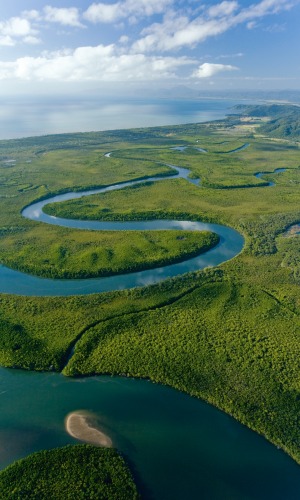
The Daintree Ferry makes its first crossing for the day at 6:00am until midnight, seven days a week. This is the only cable ferry operating in a World Heritage area in the world. Passing over the crocodile infested river is a symbolic entry into the beautiful tropical forest. The Daintree River rises in the rugged surrounding ranges, and winds its way down to reach the sea. Here in the headwaters and estuary, rich in mangroves and lush swamp forest, can be found rare and prolific bird life, plants, frogs and insect species. The river supports saltwater and freshwater marine life, including the saltwater crocodile.
It is important not to step close to the riverbank and absolutely never swim in the river as crocodiles inhabit this river. The mouth of the Daintree River opens onto a giant sandbar that shifts with each changing tide. Due to the ever-shifting deep centre of the sandbar, entering the Daintree River has always been a problem for ship captains.
The river winds through thick mangrove swamps where the water remains very salty. As it progresses through the rainforest, the water turns fresh. At this section, an abundance of wildlife congregates, particularly fish. It is a bird spotters paradise, home to a dazzling array of tropical life. The best way of seeing and understanding the river's eco systems and wildlife is to take a cruise. There are many Daintree River tours to choose from, run by the locals who know the area inside out. The best river tours are the ones that capture the ambience of a tropical river system during early morning or at dusk. Some river trips specialise in wildlife at dawn and others concentrate on fishing and photography. The river trips usually take about an hour, and are the perfect introduction to the unique wildlife of the Daintree.
DAINTREE VILLAGE
Daintree Village is located on the Daintree River just a one-and-a-half-hour drive north of Cairns. This laid-back little village was originally the base for timber-cutters who came to log the red cedar and today it has a population of around 100 people, including descendants of the original settlers who are now successful beef-cattle farmers.
The Village gave it’s name to the famous World Heritage-listed Daintree National Park which stretches in sections between Mossman Gorge in the south to the Bloomfield River in the north. Before the road to Mossman was completed in 1933 the only access to the Village was by the Daintree River.
Tiny Daintree Village has a number of restaurants, galleries and shops selling local arts and crafts. The Daintree River is the place to see a crocodile in it's natural environment and the area is famous as a birdwatcher’s paradise – a number of wildlife-spotting cruises depart from the Daintree Village area.
Other attractions and activities in the region include beautiful beaches, Horse Riding, Daintree Mangroves Wildlife Sanctuary, Flower and Fruit Farms, Hoglund glass-blowing Studio, Diane Cilento’s Karnak Playhouse, Mossman Golf Club and, of course, the Daintree River ferry to Cape Tribulation (great for a day trip).
Visitors to the region are offered a wide variety of accommodation from famous eco-resorts, B&B’s, farm-stays and caravan parks to budget cabins.
HISTORY OF THE DAINTREE VILLAGE
For centuries the Daintree area was inhabited by the Kuku Yalanji people. They lived in small kinship groups of 8 to 12 in camps spread along the banks of the river and creeks between Bloomfield and Mossman. They know this area as Julaymba.
The Daintree River was only discovered by Europeans in 1873 when Scottish geologist and explorer George Elphinstone Dalrymple came across a magnificent river and named it after his friend and early government geologist, Richard Daintree. Not just the river but a village, a national park and the whole region now share his name.
Daintree Village was originally the base for timber-cutters who came to log the red cedar which once flourished in the area, and some of their original tools may be viewed in the Daintree Timber Museum & Gallery.
The Village gave it’s name to the famous World Heritage-listed Daintree National Park which stretches in sections between Mossman Gorge in the south to the Bloomfield River in the north. Before the road to Mossman was completed in 1933 the only access to the Village (which now has a population of about 100 people) was by river.
Today tourism is a major industry throughout the region but many descendants of the original settlers still live here, some operating thriving beef-cattle properties in the river valleys beyond Daintree Village while others farm sugar and tropical fruits.
Driving north from the sugar-mill town of Mossman towards Daintree the road travels through extensive areas of sugar-cane, set against the magnificent backdrop of the rainforested coastal ranges - and beautiful uncrowded beaches are only a short distance from the main road.
EUROPEAN HISTORY OF THE DAINTREE
In 1770 Captain James Cook was on an exploration voyage up the north Queensland coast, when his ship the “Endeavour” went aground on a reef.
He named the reef “Endeavour Reef” after his ship. He gave the nearest point the unforgettable name of Cape Tribulation and wrote in his diary ‘here began all our troubles’, and the mountain behind it he named Mount Sorrow – in all it was not one of his most enjoyable voyages.
The Endeavour struggled north along the coast into an inlet that is now The Endeavour River and where is now located the coastal township of Cooktown.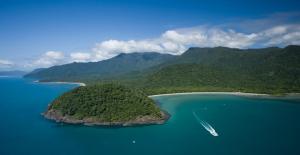
Except for a large piece of coral, found lodged in the ships hull, this story may never have made the history books!
Australia goes back to one of the most ancient countries on earth populated by the oldest race on earth, the Australian Aborigine. The original Australians were a nomadic race and other than rock paintings, carvings, middens and burial sites they left the country undisturbed.
For many thousands of years the Kuku Yalanji people occupied land between the current sites of Cooktown and Mossman.
When the gold rush arrived, things would never be the same again for the Kuku Yalanji. Cooktown became a bustling port, the second largest after Brisbane. Aboriginal people worked as labourers alongside Chinese, Malays and Islanders carving settlements out of the forest.
As the population grew, forests were cleared for sugar cane, tea and cattle. The Daintree River ferry began in the 1950’s and by 1961 the first real road reached Cape Tribulation. European occupation brought massive change.
Unlike countries with ancient man-made buildings from which many of our visitors come, Australia has a different history – an ancient natural heritage. The Flora of the Daintree includes more families of plants with primitive flowering species than anywhere in the world.
The Kuku Yalanji people continue to feel a strong responsibility for the Daintree region. Their songs and legends continue to give special
THE MASON FAMILY
Andrew Arthur Mason first settled in Cow Bay (then known as Baileys Creek) in 1927. After a failed farming venture there he moved to Cape Tribulation in 1932. At that time, he, his brothers and their respective families were the only whites in the area. On a seasonal basis, semi tribal aborigines inhabited the coastline.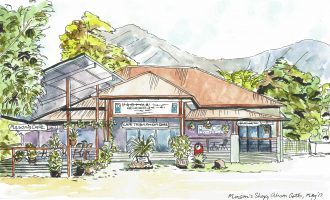
In those days the old aboriginal road was occasionally used to transport livestock, this being easier than walking it south toward the Daintree River. Also the Masons grazed cattle at Emmagen Valley, a fact that many people are surprised to learn today. The grazing leases expired and the area is now National Park and World Heritage Area.
During the second world war years, the Masons kept a horse and saddle for each person on the farm, the plan being first to walk north along the Bloomfield Track, then west or south to escape invasion. In those days the Bloomfield Track would have been the easiest way out. Luckily the escape plan was never needed.
Over the years the Mason Family witnessed many changes – from walking track to road, from would be farmers and miners to Marijuana growers and from unprotected State Forest to National Park and World Heritage Area.
Since 1981 Mason’s Tours have provided eco tourism adventures to over 150,000 visitors. Mason's Tours was founded by the late Paul Mason and celebrated 25 years of operation in 2006.
Mason’s Tours operate from the Cape Tribulation to Daintree River area.
Their experienced local guides will give you time to see, touch, smell and even taste the Far North Queensland rainforest - on your tour they will provide amazing information and answer your questions about the tropical rainforest plants and trees, birds, insects, frogs, forest dragons, snakes and crocodiles to give you a unique wilderness experience and unforgettable memories of your visit to the World Heritage Listed Daintree Rainforest and Cape Tribulation National Park.
THE BLOOMFIELD TRACK
For perhaps thousands of years, the Kuku Yalangi Aboriginal people lived along this section of coastline. For this reason, when whites arrived a well used track existed from Cape Tribulation to the Bloomfield River. As early as the 1880s a timber cutter called Hal Collins used it to search for Red Cedar.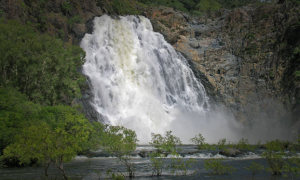
First attempts to upgrade it came in 1968 when a privately funded group of local farmers bulldozed a ‘pilot track’. They perhaps felt that a coastal road link through to Cooktown would improve their land values.
The ‘pilot track’ was narrow, avoiding large trees, and not graveled, sections of it exceeded 33% (1:3) in gradient. It was open only a few weeks, the rain closed it. The harsh terrain won round one and it was some time before anyone bothered to reopen it. In 1978, a land developer reopened it but the end result was the same.
For 14 years it was essentially a walking track. In those 14 years a number of things happened. Ancient flowering plants were discovered in the Daintree Rainforest. Tourists began to visit in increasing numbers and the Daintree began metamorphosis from a farming area to a tourist area. In 1981, The Cape Tribulation National Park was gazetted.
Further south in Mossman, old plans for a widened, graveled Bloomfield Road were revitalized. The Douglas Shire Council began construction in 1982. Protesters tried to stop the road, leading to several arrests. In spite of almost no local support, the road was built in a matter of weeks. The protesters won in the end though, the publicity surrounding the issue resulted in the nomination and subsequent inclusion of the area on the World Heritage List.
Another interesting thing about the protest is that the protest leader, Mike Berwick, stood for mayor of the council he protested against and won! In 2003 he was still mayor. This more than anything else indicates the mood of the community and the change in people’s views about the environment at that time.
Currently the future of the road is uncertain. No decision has been make about the road but the high cost of road building and low population it serves means that it will probably remain a 4wd Track for some time to come.
Masons Tours will show you pictures of the protest and talk a little about the issues surrounding ‘the road’. The Mason Family were involved in the building of the initial pilot road, and later opposed the road in the 1980s. Hans, one of the guides, was a protester who took direct action to try to halt construction. There is not much Masons don’t know about the road or the area.
DAINTREE BEACHES
The beaches of the Daintree Rainforest are rated among the most spectacular in the world - golden sand, calm blue water and mostly deserted. They are pristine.
One of the most wonderful features of Daintree beaches is the lack of people. Stretching for miles, you can cast your eyes along the golden sand and not see a single soul.
The Cape Tribulation coastal strip offers secluded swimming bays and long expanses of sandy beaches for leisurely walks. If you stand in the water you can view the undisturbed coastline, a rainforest backdrop with steep ranges and luxuriant foliage. 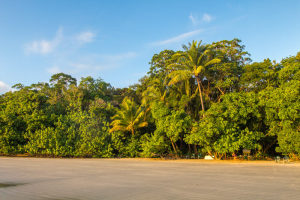
Beach swimming is seasonal. From about November to April marine stingers inhabit the area. They are not easily seen, as some stingers are just the size of a thumbnail, but they can cause painful and even life threatening injuries. Visitors are advised to stay out of the water completely during these times.
Swimming at this time of the year is generally limited to natural water holes, swimming pools and reef trips where the boat is at least 15 kms off the coast.
Cape Tribulation Beach is the showcase beach of the area. Protected by the Cape Tribulation headland, the water here is almost always calm and crystal clear. Tourist operators visit this beach every day of the week, so there are often many people here.
Coconut Beach is accessed through a resort, but can also be reached slightly further south of the resort from the main road. It is 2 kms south of Cape Tribulation, and has a large reef that lies offshore. The depth of water drops significantly at the edge of the reef, making this a good fishing location. You can walk north along the beach to the river mouth of Myall Creek, but do not cross - as large crocodiles live here!
There are normally very few people at Emmagen Beach, so you can pretend to be Robinson Crusoe. Looking out to the Coral Sea, it is easy to imagine that you are alone in the world.
A little further along the road is Donovans Beach. It’s too far to walk from accommodation in the Daintree Rainforest, so you’ll need a car or bicycle to reach it. To reach Donovans beach, turn off a dirt track near Emmagen Beach and follow it for about 200 metres. There have been sightings of crocodiles on this beach, and as a result only brave people visit it.
Noahs Beach has a camping ground, which is frequently occupied. A self-registration booth is located at the entrance to the park, and guests must complete a permit form a pay a small fee to the collection box. Rangers do make periodic trips to the park to check that visitors are using the facilities in an orderly manner.
Accommodation in the Daintree
To truly experience what this amazing region has to offer, you need to stay for more than a day...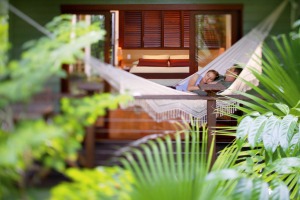
The Daintree is a very unique rainforest experience and to gain the most out of your visit we recommend to stay overnight. Most stays range from 1 - 3 nights and there are many accommodation options to choose from in the Daintree Village, then over the river in Cow Bay, Alexandra Bay, Cooper Creek and Cape Tribulation.
Accommodation ranges from four star resorts, to boutique cabins, luxurious rainforest retreats, self contained holiday houses, backpackers and camping grounds all in unique settings.
You will get a better appreciation of the local area if you plan to stay more than a day. There is so much to do, and the Daintree Rainforest is a great place to relax and unwind.
DAINTREE TEA
From the heart of the “Daintree Wilderness” comes a truly unique drink grown to satisfy both the tea lover and the health-conscious consumer...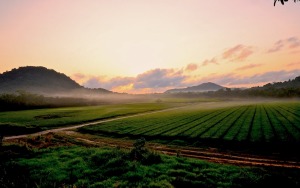
The Daintree Tea Company is located on the Cubbagudta Plantation, situated in the heart of the Daintree Wilderness area. This is the perfect growing environment for a unique tasting tea, free from tannic acid and pesticides residues. These conditions result in a product which gives the discerning tea drinker a more natural flavoured and environmentally friendly tea.
The Cubbagudta Plantation was established in 1978, by the Nicholas family, who still own and operate the business. The name Cubbagudta means "Rainy place" in the language of the local Kuku Yulangi Aboriginal people.
Harvesting plucks the soft green shoots on a regular basis, approximately two weeks apart. Once plucked the young leaf is transported to the processing factory, where it is firstly withered, then crushed, oxidied, dried, sorted and packaged. From the time the leaf is first picked, to the time it is packaged, a mere 24 hours has passed, which ensures one of the freshest tea products available on the Australian Market.
Daintree Tea is 100 per cent Australian owned, grown and processed. You can buy Daintree Tea from most shops in the Daintree region or place an order through their web site www.daintreetea.com.
WET TROPICS
Management of the Wet Tropics Area is the responsibility of the Wet Tropics Management Authority, a Cairns-based agency funded by the Queensland and Australian Governments.
The Wet Tropics World Heritage Area stretches between Townsville and Cooktown in northern Queensland. It contains some of the most beautiful and dramatic landscapes in Australia. It consists of 894,420 hectares of tropical rainforest, open eucalypt forests, swamps and mangrove forests. Covering just 0.12% of the continent, the Wet Tropics is one of the most diverse regions of Australia. The forests here are a living museum of ancient species and a record of the major stages in the earth’s evolutionary history.
Rainforest Aboriginal culture
Although not listed for its cultural values, the Wet Tropics is recognised as a living cultural landscape for 18 Rainforest Aboriginal tribal groups. Their lives, customs and beliefs are intricately entwined with the plants, animals, waterways and seasons of the tropical rainforests.
The Wet Tropics has provided food, shelter, medicine and a way of life to many generations of Rainforest Aboriginal people. As the Traditional Owners of the Wet Tropics they are also the guardians of their culture. Please respect traditional customs and culturally sensitive sites when sharing the World Heritage Area with visitors.
Animals 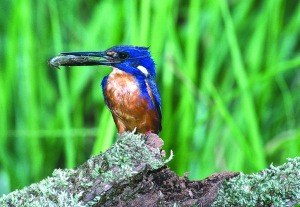
One of the major drawcards of tropical north Queensland is the abundance of wildlife found here. From the tiny pygmy possum to the magnificent cassowary, Wet Tropics animals abound and astound. At least 663 land-based vertebrate species have been recorded here – 32% of Australia’s vertebrate animals. This includes 66 species that are only found in the Wet Tropics region.
The Wet Tropics boasts:
- 34% of Australia’s mammal species
- 40% of its bird species
- 28% of its frog species
- 20% of its reptile species
- 42 % of its freshwater fish species and
- 60% of its butterfly species.
Plants
From microscopic mosses to giant kauri pines, the Wet Tropics World Heritage Area possesses over 2,800 known species of plants. It also has the highest concentration of primitive plant families on earth.
- Found in the Wet Tropics are:
- 65% of Australia’s fern species
- 21% of its cycad species
- 37% of its conifer species
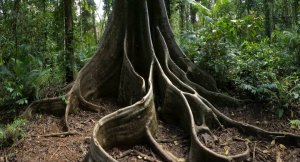
- 30% of its orchid species.
To be inscribed on the World Heritage list a place must have outstanding universal value above and beyond its significance for a particular nation. World Heritage sites are important to all the peoples of the world.
The Wet Tropics was inscribed on the World Heritage list in 1988 because:
It is the oldest continually surviving tropical rainforest on earth.
It has Australia’s greatest diversity of animals and plants.
It protects areas where rare and threatened species still survive.
It contains areas of exceptional natural beauty.
For further information please visit: www.wettropics.gov.au
THE DAINTREE
By: Sue Fuller - Australia
It's a little known fact that the Daintree Rainforest, an ancient World Heritage-listed wonderland in our own backyard, is older than the Amazon.
Every year, several hundred thousand people from around the world make sure the Daintree is on their travel itinerary, but this most magical of ancient rainforests is a great drive destination and is still a well-kept secret from many Queenslanders.
It's here the velvety green mantle of the forest slopes plunge to the aqua waters of the Great Barrier Reef Marine Park, where fringing reefs grow almost to the shore. No where else in the world can you experience these two natural wonders side by side - where World Heritage-listed reef and rainforest actually meet.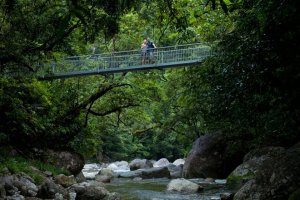
The Daintree Village, just an hour-and-a-half drive from Cairns or 45 minutes from Port Douglas, is the perfect base from which to explore the region.
From the village, the wonder of the Daintree and Cape Tribulation is on your doorstep. There are flora species that have survived almost unchanged for 110 million years. Indeed, these rainforests actually contain several of the first flowering plants (called angiosperms), which were the origins of all plant life.
No great shakes in the botanical department, I was lucky enough to hook up with one of the region's great characters, Dan Irby. One of the most magical ways to experience the Daintree is with Dan Irby's Mangrove Adventures . At sunrise and sunset, Dan runs small, personalised tours of the Daintree River, focusing on the area's natural history. Dan has years of experience in medical and zoological research. His passion for the Daintree is absolutely infectious and we were soon enthusiastically croc spotting, bird watching and learning about the unique flora and fauna.
You can make your own way into the Daintree via the Daintree Ferry. It's the only cable ferry in tropical Australia, and drops you on the southern part of the lowland Daintree Rainforest. The ferry operates from 6:00am to midnight every day, and the cost for a standard vehicle is $20 return.
There are plenty of day trips and activities to choose from including Aboriginal-guided rainforest walks with the local Kuku Yalanji people, river wildlife cruises, guided bird spotting, Cape Tribulation safaris, river fishing, horse riding and bike riding, exploring secluded beaches and 4WD safaris.
Cooper Creek Wilderness offers guided day and night interpretive rainforest tours. Or you can tackle the tracks on your own on the Marrdja Boardwalk, a 1.1km loop which takes 30 minutes.
You don't need a champagne budget to explore this beautiful region. It's one of the best driving adventures around and it's right on our doorstep.















